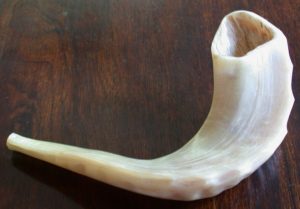Let’s talk a little bit about shofars since they appear so frequently and play an important role in the Scriptures.
A shofar is an animal horn, usually taken from a ram.
The first thing you need to know is that when our English Bibles translate shofar into “trumpet”, that’s a mistake.
Shofars were NOT musical instruments.
They were signaling devices.
Shofars were also different than the ritual trumpets blown by the priests and Levites at the Temple during religious services.
A regular Hebrew citizen would have been forbidden from using such instruments.
We do know that the Levites blew metal horns that were deliberately molded to resemble the horns of a ram.
These were called YOBEL.
Technically speaking, YOBEL means “animal horn” but normally the word was used to refer to the trumpets or horns blown during the Jubilee year observances.
There were two types of Jubilee horns used.
One type was jumbo sized Ram’s horns.
The other type were metal horns (shaped to look like animal horns).
No one knows for sure when the metal horns called YOBEL actually came into use.
However, what we do know with certainty is that it would be a good 50 years or so before Israel would observe their first Jubilee year.
Hence, the horns the priests blew at Jericho were probably large-sized horns taken from rams.
So how exactly were Shofars utilized during battle?
Well, the piercing shriek of Shofars made them perfect instruments for signaling to the soldiers when to retreat, move forward, gather together or conduct any other common maneuver normally required in a battle.
They were also used as a rallying cry signaling to all the soldiers that war was about to begin.
And of course we shouldn’t overlook how the prophets used shofars whenever they were about to announce a new prophetic message they had received from the Lord (usually warning the people that judgement was on the way if they didn’t repent).
At Jericho, literally hundreds of shofars were being blown by Israel’s soldiers as they marched around Jericho.
However, don’t think that all 600,000 of Israel’s male fighting men were present.
The phrase “fighting men” is actually referring to the 40,000 warriors enlisted from the tribes of Reuben, Gad, and Manasseh.
Remember, these were the tribes that decided to live outside of the Promised Land on the eastern side of the Jordan River.
They had made a promise that when the time for Holy War came, they would fight alongside their brothers and they were now making good on that promise.
The soldiers from these tribes were considered the “Navy Seals” of their time and would lead a majority of the battles Israel would be fighting.
Understand that at this point in time, Israel was still a good half-days walk away from the city of Jericho.
They were camped near GILGAL having a momentary time of silence before they would be summoned to wage Holy War against the citizens of Canaan.




Leave a Reply